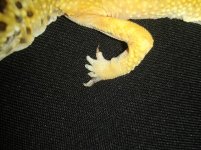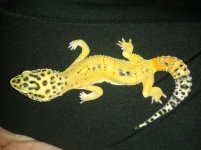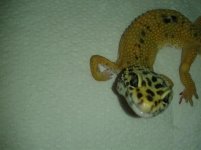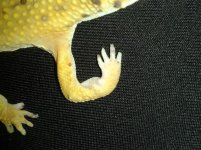Hi Everyone!
New here, in need of your opinions!
Four days ago I went over to my little neighbours house because she wanted me to look at her leopard gecko which I knew that healthy when she got him. When I got there I was disgusted and told her in how bad of condition her gecko was in. He had several lays of shed built up on its feet and several layers built up on its head, so that it couldn't even see! The gecko was on some wood chip-moss like substrate with a heating pad for humans underneath and no calcium supplement was given or offered in a dish! I told the little girl I was taking her gecko to try and nurse it better. I had to get the poor thing out of those horrid conditions.
When I got the gecko home, the first thing I did was removed the stuck shed from his head. There were three layers stuck on his head . He could finally see again! But then I noticed this gecko had more problems than just not being able to see. Because of the layers upon layers up built up shed on its feet, it obviously lost all its toes, but its legs became deformed as a result of trying to walk with all the shed stuck on his feet and toes. From the way the legs look now, I'm very skeptical about the quality of life this little gecko is going to have, right now he's pulling himself around using his "forearms" and sliding on his belly. Also one of his rear legs is also deformed, I'm wondering if the bones have become so weak from vitamin deficiency that they're just bending (because he also had significant shed built up on the rear foot and had to find a way to walk) or might this leg be broken. I want to know if anyone's seen anything like this before.
. He could finally see again! But then I noticed this gecko had more problems than just not being able to see. Because of the layers upon layers up built up shed on its feet, it obviously lost all its toes, but its legs became deformed as a result of trying to walk with all the shed stuck on his feet and toes. From the way the legs look now, I'm very skeptical about the quality of life this little gecko is going to have, right now he's pulling himself around using his "forearms" and sliding on his belly. Also one of his rear legs is also deformed, I'm wondering if the bones have become so weak from vitamin deficiency that they're just bending (because he also had significant shed built up on the rear foot and had to find a way to walk) or might this leg be broken. I want to know if anyone's seen anything like this before.
Another question is is there anything I can put on the toes that just have recently fallen off to help them heal?
Lastly, I'm feeding him Lafeber's Emeraid for Carnivors which I got from the vet last time I brought a critically ill gecko in. I live in a very small town and the vets don't have much to offer and I really can't afford to bring this poor guy in.
I have him in a small aquarium on paper towel and am monitoring the temperatures which are fine.
What do you think about his legs?
I'm attaching pictures (I hope this works!)
New here, in need of your opinions!
Four days ago I went over to my little neighbours house because she wanted me to look at her leopard gecko which I knew that healthy when she got him. When I got there I was disgusted and told her in how bad of condition her gecko was in. He had several lays of shed built up on its feet and several layers built up on its head, so that it couldn't even see! The gecko was on some wood chip-moss like substrate with a heating pad for humans underneath and no calcium supplement was given or offered in a dish! I told the little girl I was taking her gecko to try and nurse it better. I had to get the poor thing out of those horrid conditions.
When I got the gecko home, the first thing I did was removed the stuck shed from his head. There were three layers stuck on his head
Another question is is there anything I can put on the toes that just have recently fallen off to help them heal?
Lastly, I'm feeding him Lafeber's Emeraid for Carnivors which I got from the vet last time I brought a critically ill gecko in. I live in a very small town and the vets don't have much to offer and I really can't afford to bring this poor guy in.
I have him in a small aquarium on paper towel and am monitoring the temperatures which are fine.
What do you think about his legs?
I'm attaching pictures (I hope this works!)
Attachments
Last edited:







